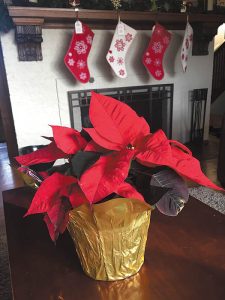January 1, 2024
Yard and Garden: Selecting and Caring for Poinsettias

photo credit: Iowa State University Extension
…a poinsettia should remain
attractive for several weeks,
well after the Christmas and
New Year’s Day holidays.
By Aaron J. Steil
Iowa State University Consumer Horticulture Extension Specialist
One of the best parts of the holiday season is adding colorful seasonal plants to the home. That includes the poinsettia. However, poinsettias do require special care to reach their full potential. Horticulture specialists with Iowa State University Extension and Outreach offer tips and tricks to keeping your poinsettia healthy and beautiful through the new year.
Poinsettias are available in a wide range of colors. Red is the most popular color, though poinsettias are also available in burgundy, pink, salmon, white, cream and gold. There are also bicolored, marbled and speckled poinsettias. The colorful part of the poinsettia, commonly referred to as the plant’s flowers, are actually modified leaves or bracts. The true flowers are yellow to green, button-like growths located in the center of the bracts.
When selecting a poinsettia, choose a well-shaped plant with dark green foliage and well-colored bracts. The true flowers should be shedding little or no pollen. Avoid poinsettias with wilted foliage, broken stems or few leaves.
How do I care for a poinsettia?
Place the poinsettia in a plant sleeve or carefully wrap it before transporting the plant home. Exposing the plant to freezing temperatures, even for a few minutes, may cause its bracts and leaves to blacken and drop. As soon as you get home, unwrap the poinsettia and place it near a sunny window or other well-lit location. To avoid cold injury, don’t let the plant touch the cold windowpane and keep the poinsettia away from cold drafts or heat sources. Poinsettias prefer temperatures between 60 and 70°.
Water needs can be determined with your finger. Check the potting soil frequently, and when the soil’s surface becomes dry to the touch, water the plant until water begins to flow out the bottom of the pot.
When given good care, a poinsettia should remain attractive for several weeks, well after the Christmas and New Year’s Day holidays.
How often should I water my poinsettia?
The key to watering a poinsettia is frequently checking the moisture content of the potting soil. When the soil surface becomes dry to the touch, water the plant until water begins to flow out the bottom of the pot. Discard excess water. The pots of most poinsettias are set inside decorative pot covers. When watering these plants, carefully remove the poinsettia from the pot covering, water the plant in the sink, then drop the poinsettia back into its pot cover. Both over- and under-watering cause problems for poinsettias. Over-watering will cause the lower leaves to turn yellow and drop. Over-watered plants may also develop root rot and die. Dry plants will wilt and drop leaves prematurely.
What should I do with my poinsettia after the holidays?
If given good care in the home, poinsettias should remain attractive for two to three months. Dispose of the poinsettia when you tire of it, or when it becomes unattractive.
For those home gardeners who enjoy a challenge, it is possible to get the poinsettia to bloom again next season. Cut the stems back to within 4 to 6 inches of the soil in March. The poinsettia may also be repotted at this time. When new growth appears, place the poinsettia in a sunny window. Continue to water the plant when the soil surface becomes dry to the touch. Fertilize every two weeks with a dilute fertilizer solution.
In late May, move the poinsettia outdoors. Harden or acclimate the plant to the outdoors by placing it in a shady, protected area for two or three days, then gradually expose it to longer periods of direct sun. The poinsettia should be properly hardened in seven to 10 days. Once hardened, dig a hole in an area that receives six to eight hours of sunlight and set the pot into the ground. To obtain a compact, bushy plant, pinch or cut off the shoot tips once or twice from late June to mid-August. Continue to water and fertilize the plant outdoors.
The poinsettia should be brought indoors in mid-September. Place the plant in a bright, sunny window. The poinsettia is a short-day plant. Short-day plants grow vegetatively during the long days of summer and produce flowers when days become shorter in fall. To get the poinsettia to flower for Christmas, the plant must receive complete darkness from 5 p.m. to 8 a.m. daily from early October until the bracts develop good color, usually early December. Protect the plant from light by placing it in a closet or by covering it with a box. During the remainder of the day, the poinsettia should be in a sunny window.
Is the poinsettia poisonous?
The poinsettia has long been regarded as poisonous. However, research conducted at various institutions has shown that poinsettia is not poisonous. While the poinsettia is not poisonous, it is not intended for human or animal consumption. Individuals are still advised to keep the
poinsettia out of the reach of small children and pets.
One potential health problem associated with the poinsettia is dermatitis or an irritation to the skin. When a poinsettia stem is cut or broken, milky sap oozes from the wound. Some individuals may develop a skin irritation if the milky sap comes in contact with their skin.
Aaron J. Steil, Consumer Horticulture Extension Specialist a with Iowa State University Extension, can be reached at 515-294-8953 or www.extension.iastate.edu/news/aaron-j-steil.
Filed Under: Health & Wellness, News
Trackback URL: https://www.50pluslife.com/2024/01/01/yard-and-garden-selecting-and-caring-for-poinsettias/trackback/


